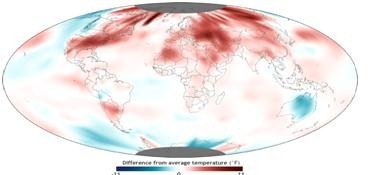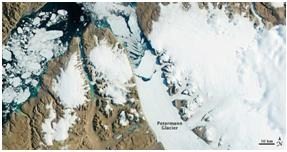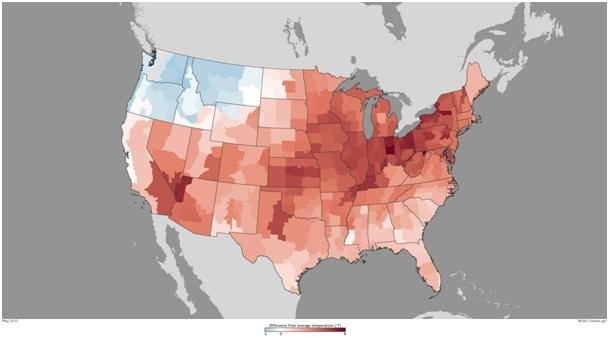According to the State of the Climate Global Analysis recently published by NOAA- the National Atmosphere and Ocean Administration -, the globally-averaged land surface temperature for May 2012 was the all-time warmest on record, at 1.21°C (2.18°F) above average (fig.1). It also broke a record as the warmest May in the Northern hemisphere, closely following the global record of May 2010. The consequences are evident all across the Northern hemisphere.
 Illustration 1 - Global land temperatures in May 2012 is warmest on record, NOAA.
Illustration 1 - Global land temperatures in May 2012 is warmest on record, NOAA.
Satellite
images are showing that the Peterman Glacier, in Northwest Greenland, has shed
a chunk of ice of 120 sq km, twice the size of Manhattan, with consequent
raising of the ocean and air temperatures in Northern Greenland (fig.2). Illustration 2 - The Petermann Glacier. Credit: NASA
Illustration 2 - The Petermann Glacier. Credit: NASA
Another
result of this warming drive, according to the National Snow and Ice Data
(NSID) of the NOAA, is that the thawing permafrost is turning the Arctic area
from carbon sink to carbon source. Indeed permafrost thaw will release carbon
at the same rate as current deforestation. But these emissions also include significant quantities of methane, so
that the overall effect on climate could be 2.5 times that of
deforestations. Recent reports from the far North bring evidence of tundra
fires, the release of ancient carbon, CH4 bubbling out of lakes (fig. 3) and
gigantic stores of frozen soil
carbon. As reported in Nature last November 2011, “one of the latest estimates
is that some 18.8 million square kilometres of Northern soils contain about
1,700 billion tonnes of organic carbon - which represent the remains of plants
and animals that have been accumulating in the soil over thousands of years.
That is about four times more than all the carbon emitted by human activity in
modern times and twice as much as is present in the atmosphere now”.  Illustration 3 - Methane collects beneath the ice in distinctive
Illustration 3 - Methane collects beneath the ice in distinctive
bubble patterns, NY Times.
In the other hemisphere by the end of the year, the Pacific ocean might see the possible return of El Niño, a warm oceanic stream able to destabilize most of the precipitations regimes from Chile to China. But even far from Siberian tundra, Arctic islands, and South Pacific, climate makes headlines at Reuters, New York, July 2 2012: “more than 2,000 temperature records were matched or broken in one week as a brutal heat wave baked much of the United States, and the whole month saw more than 3,200 records topped, the NOAA said Monday.” (fig.4).
 Illustration 4 - At
end of May, year-to-date temperature
Illustration 4 - At
end of May, year-to-date temperature
warmest on record, NOAA
Such
convincing evidence about global warming and its weird manifestations, however,
is not conducive to agreement on policy to combat it. Approaching the American elections,
the debate between those who urge taking action and those who claim that we
humans cannot be held responsible for the vagaries of the weather is heating
up. Sceptics
maintain that wide thermal variability independent of human activity has always
been normal, and that climate change remains 'manageable'. Others reply that
droughts and heatwaves in North America are devastating a substantial part of
the corn crop (sending its 2013 price
up), forest fires are ravaging vast residential areas in Colorado, and parts of
the American coast are predicted to go under water during the century. As the
list goes on, the situation looks less manageable than is claimed.
Scorching
temperatures and lack of rain in spring, and snow in winter, are dooming the
same crops and livestock whose American producers usually are global warming
deniers. They are supporters of the same party made up of those who allegedly
profit from activities that lead to global warming, such as oil companies,
polluting industries, and the financial and political sectors that feed off
them. As the
debate heats up, other national governments remain ineffective. Some say that
each government would be disadvantaged in the global market if it acted alone
to regulate carbon emissions. Indeed, capital flight and consequent job losses
would alienate national electorates. The huge amount of money flowing from big
corporations to politicians are another obstacle to progress.
In March 2012, the U.S. Chamber of Commerce sent a petition to the U.S. Environmental Protection Agency, EPA, that it should avoid regulating carbon emission because in the event of global warming, “population can acclimatize to warmer climates via a range of behavioural, physiological, and technological adaptations.” The U.S. Chamber of Commerce in 2009 surpassed both the Republican and Democratic National Committees on political spending, in a country that makes up 19% of global carbon emissions. The use of fossil fuels remains predominant, stimulating the same polluting cycle of production, without providing incentives to make the transition to renewable energy. To break this vicious circle, an alternative is that all countries take simultaneous decisions to tackle global warming. That was supposed to be the goal of meetings such as Rio 2012, Copenhagen 2009, or the Kyoto protocol, effective since 2005, which called for all national policies to converge onto a common agenda to limit greenhouse gases that contribute to global warming and climate change. International panels fixed 2 degrees Celsius as the limit to the rise in temperatures that reasonably corresponds to 565 Gigatons of carbon dioxide by mid-century. But the estimated amount of carbon present in the coal, gas and oil reserves of the fossil fuel companies is 2795 Gigatons. That figure is five times higher than 565, and it is already built in national budgets and companies' financial plans. On the top of it, as reported by AP in New York in March 8 2012, “Exxon says it will spend $185 billions over the next five years to find new sources of oil and natural gas.”
While newspapers blanket the world with words like catastrophe, apocalypse and calamity, scientific evidence is flooding out from expert circles to preoccupy government advisers. We are approaching tipping points of non-reversibility in our biosphere, and experimental data are likely to be interpreted as a matter of economic and civil security. That might develop toward tipping points of political non-reversibility, prompting governments to finally endorse simultaneous environmental policies. Meanwhile, the climatic crisis is making the planet hotter, smaller and more paranoid by the season.
by Alessandro Tonnetti

